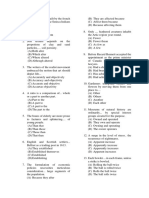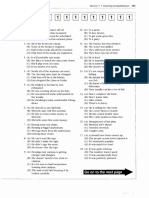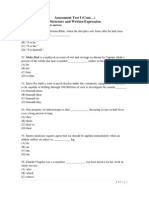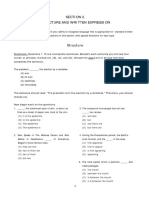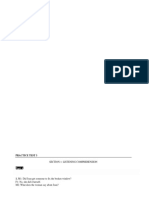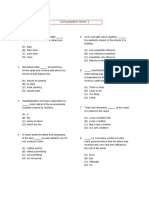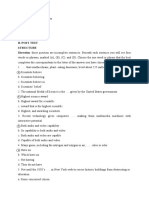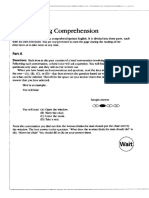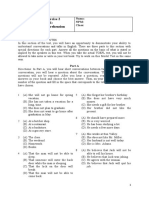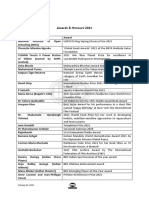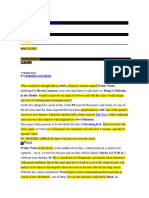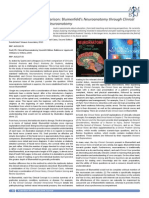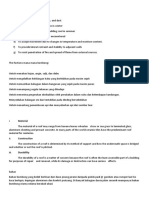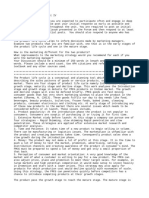3A3A3A3A3A3A3A3
Questions 1-10
, Englishman Edward Stone
Aspirin's origins go back at least as early as 1758. In that year
distinctive bitter flavor in the bark of the willow tree . To Stone, this particular bark seemed
noticed a
medicinally since the 1640s to .
to have much in common with “ Peruvian Bark ,” which had been used
decided to test the effectiveness of the willow bark. He
Line bring down fevers and to treat malaria. Stone
its properties. His tests
(5) obtained some , pulverized it into tiny pieces, and conducted experiments on
temperatures and
demonstrated that this pulverized willow bark was effective both in reducing high
aches and pains . In 1763 , Stone presented his findings to the British Royal Society.
in relieving
studies on the medicinal value of the willow bark were being
Several decades later further
,
that the
conducted by two Italian scientists. These chemists , Brugnatelli and Fontana , determined
( 10 ) active chemical that was responsible for the medicinal characteristics in the willow
bark was the
chemical salicin , which is the active ingredient of todays aspirin.
The name "aspirin ” is the trade name of the drug based on the chemical salicin , properly known
as acetyl salicylic acid . The trade name “ aspirin" was invented for the drug in the 1890s by the Bayer
Drug Company in Germany. The first bottles of aspirin actually went on sale to the public just prior
to
( 15 ) the turn of the century, in 1899.
1 . According to the passage , aspirin 5. What did the willow bark look like after
originated Stone prepared it for his experiments?
(A) no later than 1758 (A) It was in large chunks.
( B) sometime after 1758 ( B) It was a thick liquid.
( C) definitely sometime in 1758 ( C) It was a rough powder.
( D) no earlier than 1758 ( D) It was in strips of bark.
2 . It can be inferred from the passage that 6. The Italian chemists mentioned in the
Peruvian Bark passage most probably conducted their
studies on willow bark
( A) caused fevers
( B) was ineffective in treating malaria ( A) in the 1750s
( C ) was described to the British Royal ( B) in the 1760s
Society by Stone ( C) in the 1770s
( D ) was in use prior to aspirin ( D) in the 1780s
3. The pronoun "it ” in line 5 refers to 7. What is true about Brugnatelli and
Fontana ?
(A) malaria
( B) willow bark ( A ) They were from Italy.
(C) effectiveness (B) They added a chemical to the willow
( D ) the British Royal Society bark.
( C) They conducted studies on the willow
4. The word "properties” in line 5 could best bark .
be replaced by ( D ) They were medical doctors.
(A ) ownership 8. The expression "prior to” in line 14 could
(B) body best be replaced by
( C) characteristics
( D) materials ( A ) at
( B) before
(C ) during
( D) after
k
GO ONTO THE NEXT PAGE
7
356 READING COMPREHENSION POST TEST -
�3 3 3 3 3 3 3 3
9. The word "turn ” in line 15 could best be 10. Where in the passage does the author
replaced by name the scientific compound that makes
up aspirin ?
(A) spin
( B) comer ( A) Lines 2-4
(C ) change ( B) Line 7
( D) reversal (C ) Lines 8-9
( D) Lines 12-13
1
^
GO ON TO THE NEXT PA E
r
READING COMPREHENSION POST-TEST 357
� 3A3A3A3A3A3A3A3
Questions 11-20
Herman Melville, an American author best known today for his novel Moby Dick , was actually
more popular during his lifetime for some of his other works. He traveled extensively and used the
knowledge gained during his travels as the basis for his early novels. In 1837 , at the age of eighteen ,
Line Melville signed as a cabin boy on a merchant ship that was to sail from his Massachusetts home to
(5 ) Liverpool , England. His experiences on this trip served as a basis for the novel Redbum ( 1849). In
1841 Melville set out on a whaling ship headed for the South Seas. After jumping ship in Tahiti , he
wandered around the islands of Tahiti and Moorea. This South Sea island sojourn was a backdrop to
the novel Omoo ( 1847 ) . After three years away from home , Melville joined up with a U .S. naval frigate
that was returning to the eastern United States around Cape Horn . The novel While- Jacket ( 1850 )
( 10 ) describes this lengthy voyage as a navy seaman .
With the publication of these early adventure novels , Melville developed a strong and loyal
following among readers eager for his tales of exotic places and situations. However, in 1851 , with the
publication of Moby Dick , Melville’s popularity started to diminish . Moby Dick , on one level the saga
of the hunt for the great white whale , was also a heavily symbolic allegory of the heroic struggle of
( 15 ) humanity against the universe. The public was not ready for Melville’s literary metamorphosis from
romantic adventure to philosophical symbolism . It is ironic that the novel that served to diminish
Melville’s popularity during his lifetime is the one for which he is best known today.
11 . The main subject of the passage is 15. The passage implies that Melville stayed in
(A) Melville’s travels Tahiti because
( B) the popularity of Melville’s novels ( A ) he had unofficially left his ship
( C) Melville’s personal background (B) he was on leave while his ship was in
(D) Moby Dick port
( C) he had finished his term of duty
12 . According to the passage, Melville's early ( D ) he had received permission to take a
novels were vacation in Tahiti
(A) published while he was traveling
(B) completely fictional 16. A "frigate ” in line 8 is probably
( C) all about his work on whaling ships (A) an office
(D) based on his travels (B) a ship
( C) a troop
13. In what year did Melville's book about his ( D) a train
experiences as a cabin boy appear ?
( A ) 1837 17.. How did the publication of Moby Dick
( B ) 1841 affect Melville's popularity ?
( C ) 1847 (A) His popularity increased immediately.
( D ) 1849 ( B) It had no effect on his popularity.
(C) It caused his popularity to decrease.
14 . The word "basis ” in line 5 is closest in ( D) His popularity remained as strong as
meaning to ever.
( A ) foundation
( B) message
( C ) bottom
( D ) theme
k
GO ONTO THE NEXT PAGE
7
358 READING COMPREHENSION POST-TEST
�3A3A3A3 3 3 3 3
18. According to the passage , Moby Dick is 20. The passage would most likely be assigned
(A) a romantic adventure reading in a course on
(B) a single- faceted work ( A) nineteenth-century novels
(C ) a short story about a whale (B) American history
( D) symbolic of humanity fighting the (C) oceanography
environment ( D) modem American literature
19. The word “ metamorphosis" in line 15 is
closest in meaning to
(A) circle
(B) change
(C ) mysticism
(D) descent
*
1
GO ONTO THE NEXT PAGE
f
READING COMPREHENSION POST-TEST 359
� 3A3A3A3A3A 3A3&3
Questions 21-31
Although only a small percentage of the electromagnetic radiation that is emitted by the Sun is
ultraviolet ( UV) radiation , the amount that is emitted would be enough to cause severe damage to ^
most forms of life on Earth were it all to reach the surface of the Earth . Fortunately, all of the Suns
Line ultraviolet radiation does not reach the Earth because of a layer of oxygen , called the ozone layer,
(5 ) encircling the Earth in the stratosphere at an altitude of about 15 miles above the Earth . The ozone
layer absorbs much of the Sun 's ultraviolet radiation and prevents it from reaching the Earth .
Ozone is a form of oxygen in which each molecule consists of three atoms ( 03) instead of the
two atoms ( 02 ) usually found in an oxygen molecule. Ozone forms in the stratosphere in a process
that is initiated by ultraviolet radiation from the Sun . UV radiation from the Sun splits oxygen
( 10 ) molecules with two atoms into free oxygen atoms, and each of these unattached oxygen atoms then
joins up with an oxygen molecule to form ozone. UV radiation is also capable of splitting up ozone
molecules; thus , ozone is constantly forming, splitting, and reforming in the stratosphere. When UV
radiation is absorbed during the process of ozone formation and reformation , it is unable to reach
Earth and cause damage there.
( 15 ) Recently, however, the ozone layer over parts of the Earth has been diminishing. Chief among
the culprits in the case of the disappearing ozone , those that are really responsible , are the
chloroflurocarbons ( CFCs ). CFCs meander up from Earth into the stratosphere , where they break
down and release chlorine. The released chlorine reacts with ozone in the stratosphere to form
chlorine monoxide ( CIO ) and oxygen ( 02 ) . The chlorine then becomes free to go through the cycle
( 20 ) over and over again . One chlorine atom can , in fact , destroy hundreds of thousands of ozone
molecules in this repetitious cycle , and the effects of this destructive process are now becoming
evident.
21 . According to the passage , ultraviolet 24. According to the passage , an ozone
radiation from the Sun molecule
(A ) is causing severe damage to the ( A ) consists of three oxygen molecules
Earth 's ozone layer ( B ) contains more oxygen atoms than the
( B) is only a fraction of the Sun ’s usual oxygen molecule does
electromagnetic radiation ( C) consists of two oxygen atoms
( C ) creates electromagnetic radiation ( D ) contains the same number of atoms
( D ) always reaches the Earth as the usual oxygen molecule
22. The word "encircling ” in line 5 is closest in 25. The word “ free ” in line 10 could best be
meaning to replaced by
(A ) rotating ( A ) liberal
( B) attacking ( B ) gratuitous
(C) raising ( C ) unconnected
(D) surrounding ( D ) emancipated
23. It is stated in the passage that the ozone 26. Ultraviolet radiation causes oxygen
layer molecules to
( A) enables ultraviolet radiation to reach ( A) rise to the stratosphere
the Earth ( B) bum up ozone molecules
( B) reflects ultraviolet radiation ( C) split up and reform as ozone
( C ) shields the Earth from a lot of ( D) reduce the number of
ultraviolet radiation chloroflurocarbons
( D ) reaches down to the Earth
k
GO ON TO THE NEXT PAGE
7
360 READING COMPREHENSION POST-TEST
�3A3A3A3A3A3A3A3
27 . The pronoun "it ” in line 13 refers to 30. Where in the passage does the author
( A) radiation explain how much damage chlorine can
( B) process do?
( C) formation (A) Lines 1-3
(D) damage ( B) -
Lines 12 14
28. The word "culprits" in line 16 is closest in
(C) -
Lines 18 19
( D) Lines 20-22
meaning to which of the following ?
(A) 31. The paragraph following the passage most
Guilty parties
( B) likely discusses
Detectives
(C) Group members (A) the negative results of the cycle of
( D) Leaders ozone destruction
( B) where chloroflurocarbons ( CFCs )
29. According to the passage, what happens come from
after a chlorine molecule reacts with an ( C ) the causes of the destruction of ozone
ozone molecule? molecules
( D ) how electromagnetic radiation is
( A ) The ozone breaks down into three
created
oxygen atoms.
( B) Two different molecules are created.
( C ) The two molecules combine into one
molecule.
( D ) Three distinct molecules result.
W
GO ON TO THE NEXT PAGE
f
READING COMPREHENSION POST-TEST 361
� 3 & 3 A 3 A 3&3 A 3A3A3
Questions 32-40
A number of nonmetric measurements in common use may at first glance seem to lack the logic
and clarity of the metric system , with its measurements all neatly based on tens and multiples of tens.
However, these nonmetric measurements developed over time from habitual use of commonplace
Line items to make simple measurements. They might not seem like simple measurements today, but such
(5 ) is their history.
The measurements foot and yard developed based on average lengths of body parts. As can be
inferred from the name , the Romans used the term foot to describe the length of a man ’s foot , from
the base of the heel to the tip of the big toe. Though not exactly an accurate measurement , due to the
varying lengths of men ’s feet , a foot was a measurement that was easy to conceptualize and visualize
(10 ) by most people. The term yard was used extensively by the English as the measurement from the tip
of a man ’s nose to the tip of his outstretched thumb. English King Edward I redefined a yard as
equivalent to three feet in 1305 , and it still has this meaning today.
To describe longer distances , the Romans also invented the use of the term mile. The word mile
comes from the Latin word mille, which means one thousand. A mile was meant to conform to a
( 15 ) distance of one thousand paces , each pace consisting of two steps or approximately five thousand feet.
On the ocean , speed is measured in knots , with one knot roughly equivalent to one nautical mile
per hour. This measurement of speed comes from the days when sailors used a knotted rope to
determine their speed while at sea . A rope was knotted at regular intervals and tossed overboard . The
rope was let out as sand flowed through an hourglass. When the sand had passed through the hourglass ,
( 20 ) the speed of the boat was determined by counting the number of knots that had been let out .
32 . The main idea of the passage is that 35. It is NOT mentioned in the passage that
nonmetric measurements the term yard
( A ) are , in reality, quite illogical (A) was originally used to describe a
( B) lack the clarity of metric measurement based on body parts
measurements ( B ) changed in definition in the 14 th
( C ) are actually based on simple concepts century
( D ) developed from Roman ( C ) is now equal to three feet
measurements ( D ) was in use prior to the term foot
33. What is stated about the term foot as used 36. The word “ extensively ” in line 10 could
by the Romans ? best be replaced by
( A) It had nothing to do with the body ( A) lengthily
part of the same name. ( B) precisely
( B ) It was not a standard measurement. ( C) widely
( C ) It was equal in length to two ( D) occasionally
footsteps.
( D ) It was not very easy for people to 37 . What is NOT true , according to the
understand . passage?
( A ) The English word mile is derived from
34. The word "visualize ” in line 9 is closest in
meaning to a Latin word .
( B ) The Latin word mille has the same
(A ) picture mentally meanings as the English word mile.
( B) describe exactly ( C ) A distance of a mile is approximately
( C ) sketch roughly 2 , 000 steps.
( D ) measure precisely ( D ) A distance of a mile is roughly
equivalent to 5 ,000 feet .
W
GO ON TO THE NEXT PAGE
7
362 READING COMPREHENSION POST-TEST
�3A3A3 A 3A3A3A3A3
38. What is a "knot ” in line 16 ? 40. Which paragraph discusses examples of
(A) measure of measurements based on parts of the body ?
A distance
( B) A measure of force (A) The first paragraph
(C) A measure of time ( B) The second paragraph
(D) A measure of speed (C ) The third paragraph
( D) The last paragraph
39. It is implied in the passage that
( A ) a measurement in knots requires
information on both distance and
time
( B ) a knot can be used to make
measurements on land
( C ) a knotted rope could be used to
measure knots without an
hourglass
( D ) the term knot has come to be used
only recently
k
ON TO THE NEXT PAGE
7
READING COMPREHENSION POST TEST - 363













